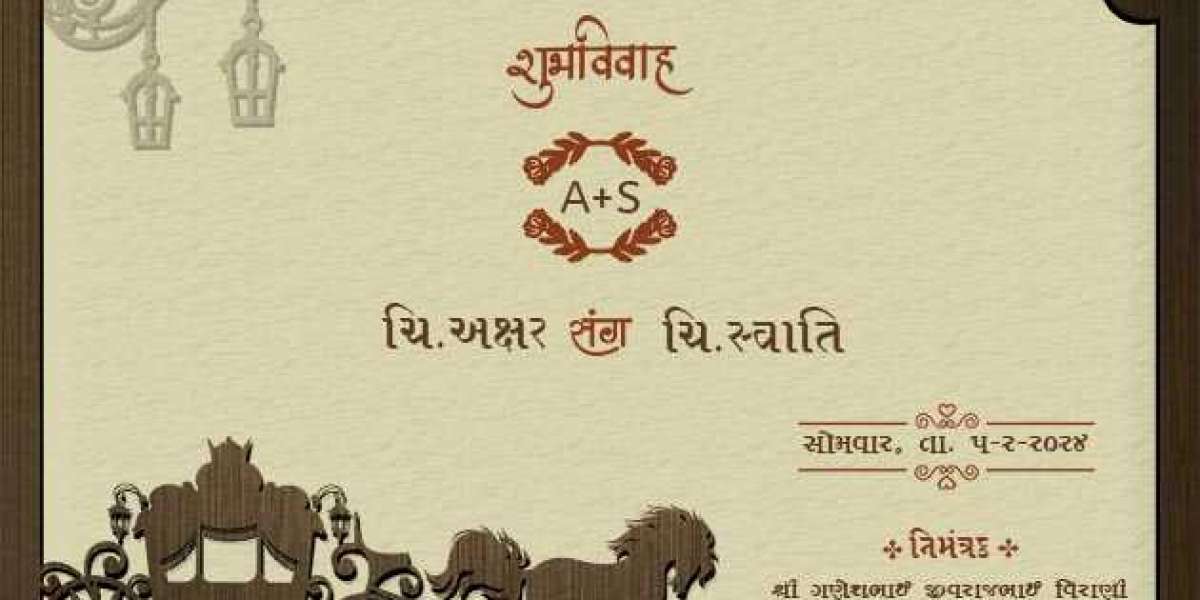The Kankotri is more than just an invitation card; it is a symbol of tradition, culture, and the profound significance of Indian rituals. Specifically, the Traditional Kankotri in Gujarati holds a unique place in Gujarati culture, where every element of its design and content is infused with meaning. As a cherished part of Gujarati weddings, engagements, and other auspicious events, the Kankotri is a reflection of the values, aesthetics, and customs passed down through generations. This article delves deep into the design and cultural significance of the Traditional Kankotri in Gujarati, exploring its various aspects and how it plays a pivotal role in the ceremonies it represents.
The Design Elements of a Traditional Kankotri
1. The Significance of Color and Paper Quality
In Gujarati culture, colors are not just aesthetic choices but carry deep symbolic meanings. The Traditional Kankotri in Gujarati often features vibrant hues like red, yellow, and gold. Red, associated with purity and auspiciousness, is a predominant color, especially in wedding Kankotris. Yellow symbolizes prosperity, while gold represents wealth and the blessings of the divine.
The choice of paper is equally significant. High-quality handmade paper or velvet-finish paper is commonly used, as it signifies the importance of the occasion. The texture of the paper adds to the tactile experience, making the Kankotri not just a visual delight but also a sensory one.
2. Traditional Motifs and Designs
The use of traditional motifs in a Gujarati Kankotri is a nod to the rich cultural heritage of Gujarat. Peacocks, elephants, lotuses, and paisleys are some of the common motifs that adorn the Kankotri. These motifs are not just decorative but carry symbolic meanings. For instance, the peacock represents beauty and grace, while the elephant symbolizes strength and wisdom.
The designs are often intricate, with detailed patterns that showcase the craftsmanship of the artisans. Embossing, foiling, and laser-cut patterns are some of the techniques used to enhance the visual appeal of the Kankotri. The borders are typically ornate, with gold or silver foil stamping that adds a touch of elegance.

3. Typography and Language
The language used in a Traditional Kankotri in Gujarati is predominantly Gujarati, written in a script that is both beautiful and traditional. The choice of words is formal, respectful, and often includes phrases from Sanskrit, especially in religious ceremonies.
The typography is usually in Devanagari script, which is ornate and complements the overall design of the Kankotri. The text is often printed in gold or silver ink, adding to the richness of the invitation. The font size and style are chosen carefully to ensure readability while maintaining the aesthetic appeal.
Cultural Significance of Kankotri in Gujarati Traditions
1. The Role of Kankotri in Weddings
In Gujarati weddings, the Kankotri is more than just an invitation; it is an integral part of the wedding rituals. The process of selecting and sending out Kankotris is considered a sacred duty. The Kankotri is often sent along with sweets or gifts, symbolizing the joy and blessings being shared with the invitees.
The content of the wedding Kankotri is also culturally significant. It typically starts with a Ganesh mantra or an invocation to Lord Ganesha, the remover of obstacles. This is followed by the details of the wedding, including the names of the bride and groom, the names of their parents, and the date, time, and venue of the ceremony. The inclusion of auspicious symbols such as the Swastika or Om further adds to the religious significance of the Kankotri.
2. Kankotri in Other Ceremonies
Apart from weddings, the Traditional Kankotri in Gujarati is also used for other ceremonies such as engagements, housewarming (Griha Pravesh), and religious functions like Satyanarayan Katha and Navratri celebrations. Each type of Kankotri is designed differently to reflect the nature of the event.
For instance, a Kankotri for a Griha Pravesh might include images of a home or a Kalash, symbolizing prosperity and the blessing of a new beginning. The text would include mantras or blessings that are specific to the occasion, along with the necessary details of the event.

3. The Emotional and Social Importance
The Kankotri also plays a crucial role in maintaining social bonds within the Gujarati community. The act of sending a Kankotri is seen as a gesture of respect and goodwill. It is a way of formally inviting friends and family to be part of a significant life event. The Kankotri serves as a reminder of the cultural values of hospitality, respect for traditions, and the importance of community.
Moreover, receiving a Kankotri is considered an honor, as it indicates that the sender values the recipient’s presence at the event. The design and content of the Kankotri reflect the sender’s personality and their regard for tradition.
Modern Innovations in Kankotri Designs
1. Fusion of Traditional and Contemporary Designs
While the Traditional Kankotri in Gujarati remains rooted in tradition, there has been a growing trend towards incorporating contemporary elements into the design. Minimalistic designs, modern fonts, and digital printing techniques are being used to create Kankotris that appeal to the younger generation while still honoring the cultural essence.
The use of eco-friendly materials such as recycled paper and natural dyes is another trend that is gaining popularity. These innovations not only make the Kankotri more sustainable but also add a unique touch to the traditional design.

2. Digital Kankotris
In the digital age, Digital Kankotris have emerged as a popular alternative to traditional printed invitations. These digital invitations can be sent via email or messaging apps, making them a convenient option for those who have family and friends spread across the globe.
However, even digital Kankotris are designed with the same attention to detail as their printed counterparts. They often feature animated elements, soundtracks of traditional Gujarati music, and interactive features that allow recipients to RSVP directly through the invitation.
Conclusion
The Traditional Kankotri in Gujarati is much more than just an invitation card. It is a reflection of the rich cultural heritage of Gujarat, a symbol of respect and goodwill, and a vital part of the rituals that mark significant life events. From its intricate design to its symbolic content, every aspect of the Kankotri is infused with cultural and religious significance.








